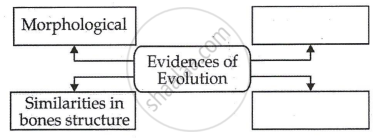Advertisements
Advertisements
Question
Enlist the evidences of evolution.
Solution
Following are the evidences of evolution:
- Morphological evidences
- Anatomical evidences
- Vestigial organs
- Palaeontological evidences
- Connecting links
- Embryological evidences
APPEARS IN
RELATED QUESTIONS
State the connecting links between Peripatus with Annelida and Arthopoda.
What are vestigial organs?
(a) Select the analogous structures from the combination given below:
(i) Forelimbs of whales and bats
(ii) Eyes of octopus and mammals
(iii) Tuber of sweet potato and potato
(iv) Tuber of Bougainvillea and tendrils of Cucurbita
(b) State the kind of evolution they represent
Given below is the list of vegetables available in the market. Select from these the two vegetables having homologous structures:
Potato, sweet potato, ginger, radish, tomato, carrot, okra (Lady’s finger)
(A) Potato and sweet potato
(B) Radish and carrot
(C) Okra and sweet potato
(D) Potato and tomato
Write the similarity between the wing of a butterfly and the wing of a bat. What do you infer from the above with reference to evolution?
Differentiate between analogy and homology giving one example each of plant and animal respectively.
State a reason for the increased population of dark coloured moths coinciding with the loss of lichens (on tree barks) during industrialization period in England.
Which one of the following pairs of vegetables is an example of homologous structures?
(A) Potato and sweet potato
(B) Carrot and radish
(C) Carrot and tomato
(D) Tomato and radish
Explain the terms analogous and homologous organs with examples.
Name the scientists who Discovered the fossil of Australopithecus
Name any two temporary embryonic structures in vertebrates which provide evidence for evolution.
Human tailbone is a vestigial organ. Explain.
Differentiate between analogous and homologous structures.
Out of bacteria, spider, fish and chimpanzee, which organism has a better body design in evolutionary terms? Give reason for your answer.
Wing of an insect and forelimb of a bird are :
(a) analogous organs
(b) analeptic organs
(c) homologous
(d) homophobic organs
The wings of a housefly and the wings of a sparrow are an example of :
(a) analogous organs
(b) vestigial organs
(c) respiratory organs
(d) homologous organs
In a class, students were asked to observe the models/slides/pictures of the skeletons of forelimbs and wings of different organisms. After the observations the students made the following groups of homologous structures. Select the correct group :
(A) Wings of a bird and a butterfly
(B) Wings of a pigeon and a bat
(C) Wings of a butterfly and a bat
(D) Forelimbs of a cow, a duck and a lizard
Define fossil.
Differentiate between connecting links and the missing links.
I am a connecting link between reptiles and mammals. Who am I?
Name the parts shown in the diagram.
Human jaw

The decaying process of C-14 occurs continuously in dead organisms only.
Complete the flowchart.

What is carbon dating?
Observe the given images and answer the following questions.

- Which evolutionary evidence does it indicate?
- What does it prove?
- State another example of evolutionary evidence.
Select the correct statement.
Why do all the gametes formed in human females have an X chromosome?
Palaeontological evidence for evolution refers to the ______.
Did aquatic life forms get fossilised? If, yes where do we come across such fossils?
Explain divergent evolution in detail. What is the driving force behind it?
I am the connecting link of annelida and arthropoda. What is my name?
Write down the difference between homologous and analogous organs.
Industrial melanism was highlighted by ______.
Complete the following conceptual picture:

Give examples of homologous organs and analogous organs in plants.
Give a definition of Palaeontology.
